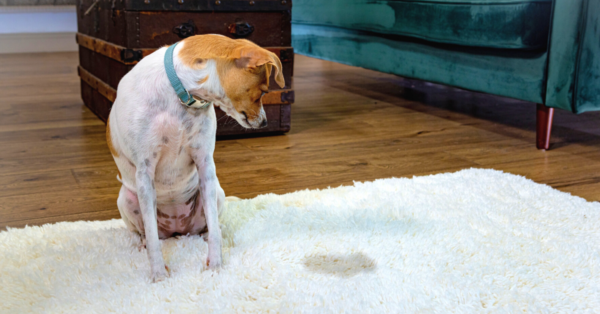Stop Dog Marking In The House
So how do you teach your dog that it’s not acceptable to mark inside?
Catch It Early Start working on prevention and training at the first sign of indoor marking. If you let it become a habit, it will be much harder to get your message across to your dog. Marking can be its own reward because it feels good and fills a natural urge. So make sure that when you’re rewarding alternative behaviors, that you use high value rewards (what your dog wants most).
Don’t Punish Your Dog Using punishment may make the problem harder to stop! This is because your dog will learn that marking when you can see him is dangerous, so he’ll wait till you’re not looking or not around. This just adds to the frustration for you and adds difficulty to his training.
Watch For The Signs …The goal is to notice your dog’s “set-up” behaviors that precede marking. Watch your dog when he’s outside. What does he do just before he lifts his leg? Often there will be sniffing and then movement of the body to get on target. This is what you need to watch for in the house, and it’s when you need to interrupt him. If you can let him know at the “thinking about it stage” that it’s not allowed in the house, you’ll make it easier to get the message to him (and will save yourself some clean-up!) But it means you’ll have to watch your dog like a hawk … and prevent marking until you can be sure he understands.
Interrupt and redirect sniffing behaviors. There are likely not very many places in your home the dog has not already sniffed. And even if you’re visiting someplace new, sniffing is not a critical behavior for your dog to do (though it may be a sign your dog is feeling stressed). So unless you’ve just dropped a dog cookie, your dog doesn’t NEED to be sniffing around. If you see your dog sniffing, call him to you … then reward him for leaving the interesting smell and listening when you called. This will get his brain on something else. Or better yet, take your dog outside when you see him sniffing!
See if he will mark outside instead. If your dog is marking outside, reward that! You want the outside behavior to have a stronger and more frequent history of reward than doing it indoors. If your dog gets “paid” high value rewards to mark outside but gets nothing if he does it indoors … why would he want to mark indoors for free? How effective this will be as the only training remedy depends on how much of a habit the marking inside has become. You will likely need to do this in addition to the other suggestions here.
Clean-up messes correctly and completely! A dog’s nose is very powerful and can detect amazingly small amounts of odor-causing bacteria and oils … or whatever else causes the scent in urine. Completely wetting the area with a cleaner that has an enzyme in it will do the best job of removing the odors. Because enzymes are living organisms, choose and store your products carefully. You don’t want to let them freeze or get too hot or sit around in storage too long, which could kill the enzymes and make the product much less effective.
Never use an ammonia-based cleaning product. Ammonia is found in urine, so it will make your dog more likely to try to cover that scent.
Regardless of the training methods above that you choose, you’ll want to also use prevention to make sure your dog isn’t marking in the house when you aren’t looking.
Belly bands are a popular method. If you search online you’ll find several sources and many colorful styles. You can also make your own out of an ace type bandage and a feminine pad. The band wraps around the dog, covering his boy parts, so that if he tries to mark, he can’t leave any liquid behind. This means that he doesn’t get the satisfaction of smelling his own scent over the other dogs. It also leaves him feeling wet and smelly himself. Some dogs are really bothered by that and others couldn’t care less. You’ll want to use training in addition to the band, otherwise your dog may need to wear the band the rest of his life. Changing the pad and washing the band is nearly as time-consuming as cleaning up messes. It’s a temporary tool, not a permanent fix.
Crates, gates, doors and leashes can also help. If your dog has specific spots he likes to mark, you may be able to stop it by restricting his access to that spot. If you want to keep an eye on your dog, but not use a crate, you can keep him leashed to you. Whether or not this is a practical solution depends on your situation and dog.
What’s the Difference Between Peeing and Marking?
Your dog may pee inside if they haven’t been let out enough, if they have a small bladder, or for many other reasons. But the peeing will result in a full puddle of urine.
Whereas, dogs that urine mark will only squirt out a small amount of urine and will often do it on the same spot or object.

Although it’s natural behavior, it’s certainly not acceptable in the house. Furniture, floors, walls, and other items are ruined or damaged when your dog decides to claim them as his own.
Urine marking is not the result of faulty housebreaking. In fact, most of the time, urine marking can be curbed with behavior modification.
Pin Me!

Prevent Scent Marking in the First Place
Related article
7 surefire tips from a certified dog behaviorist.